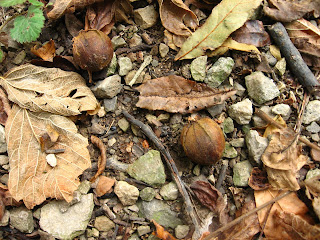The black walnut is a native tree in this part of the world, and the nuts are prized by wildlife and humans alike. The hardwood is a favorite of cabinet makers, and I remember my uncle once pointing out several old and valuable walnut trees on the farm to my aunt, letting her know that if anything happened to him and she needed money fast, these were the trees to harvest. Thankfully, they haven't needed the trees, but it is nice to know they are there, in the bank, in case of tragedy.
Preparing the walnuts for use in baking, candy, etc., is a tiresome job, as first the green husk must be removed, leaving your fingers stained with the black juice. Then the tough shells must be cracked to get at the small, flavorful nutmeats. Processing can involve hammers and plywood boards; running over the nuts on an asphalt driveway has also been advocated. I have a black walnut behind my pond, but I don't do anything with the nuts - too much like work for me.
This tree has lost nearly all its leaves, but is full of walnuts, which can be seen in the close-up photo that follows.


Several years ago, I took a series of classes at the Cincinnati Nature Center, called "A Sense of Place." The goal was to teach us to look at the things around us and learn our native wildflowers, butterflies, birds, and trees. I should know the two different kinds of nuts that are in the next photos, but I have forgotten them. (Please don't tell my instructor, Bill Creasey.) I think they are both types of hickory nuts. The first one has a thin outer shell, while the second type is much thicker. Anybody want to weigh in?



I know this one, though.



I love newly harvested buckeyes - the rich, mahogany color, the contrasting tan "eye," the slick, glossy, slightly oily feel. I picked this one up and put it in my pocket for luck. Then, I began looking around for its companions. The weird thing was, I couldn't find any more buckeyes on the ground; I couldn't even find the tree this one came from. Nuts!




7 comments:
We seem to have an incredibly large nut harvest this year. I remember carrying around a buckeye when I was a kid. It was said you could eat them but only one side was good---the other side deadly poisonous.
I think those are beechnuts. Supposed to be yummy, altho' I don't think I've ever eaten one.
Yes, they are both hickory nuts. I know the thin outer-shelled ones are Bitternut Hickory nuts and I would guess the other ones are Shagbark.
We have lots of nuts falling in the woods here, too. Last week, we took the dogs walking through the woods, and an acorn hit me right on the top of my head! I should be thankful that it wasn't a walnut - it was just a small acorn, but it smarted!
If a nut is walking in the fog, does she make any sound?
; )
Carolyn" The only buckeyes I eat are the ones made of powdered sugar and peanut butter, dipped in chocolate. Yum, yum!
Lisa: I'm not sure they were beechnuts; I didn't see any beeches, and that is one tree I am pretty confident about ID'ing.
Kirk: That's sounds right.
DG: The walnuts were falling all around me, making a heck of a racket. If one of those things hit you, you'd know it!
Susan: You so funny!
:-P
I believe beechnuts have a prickly hull and are "packed" several to a case. Small, flat-sided angular nutmeats.
I'd also agree with Kirk on his ID of the hickories.
Shagbark hickory nuts are also prized by people, if you ever get the urge to crack them!
Bitternut--well, no need to explain that one!
Post a Comment